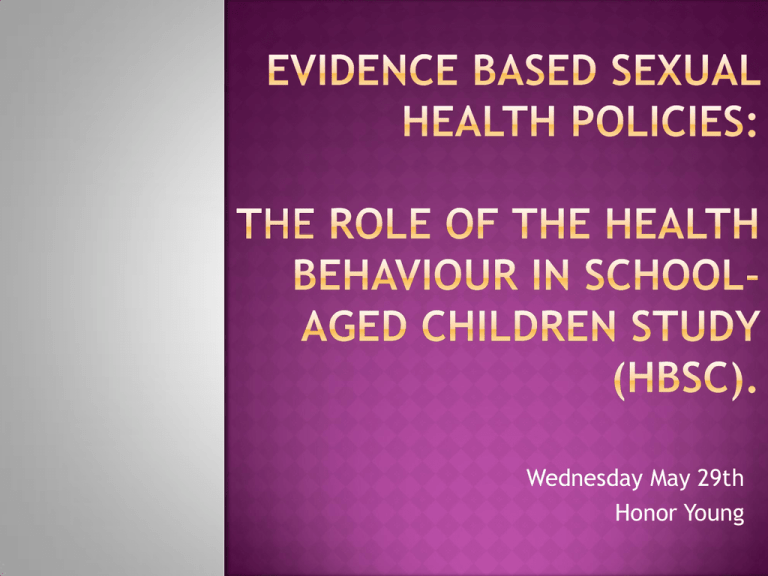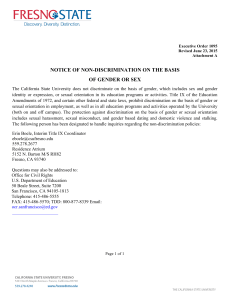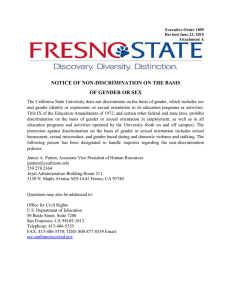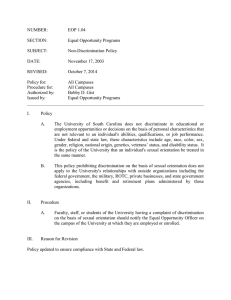Wednesday May 29th Honor Young
advertisement

Wednesday May 29th Honor Young Sexually Transmitted Infections (STIs) 13,259 notifications of STIs in 2011, an increase of 12.2% when compared with 2010 Crisis Pregnancy 35% of women and 21% of men experienced crisis pregnancy in 2010 13% of all pregnancies (1 in 8 pregnancies) Abortion 21% of crisis pregnancies result in abortion Women giving Irish addresses in UK abortion clinics 2006 (n=5042) (Health Protection Surveillance Centre 2010; 2011, ICCP, 2010) STIs 59.3% of STI notifications among 20 to 29 years 11.3% of STI notifications from under 20 years 1995 (n=147), 2011 (n=1536) Crisis Pregnancy 66% of females and 31% of males reported crisis circumstances of pregnancy (ICCP) Abortion 31% of crisis pregnancies resulted in abortion (ICCP) (Health Protection Surveillance Centre 2010; 2011, ICCP, 2010) Adverse health outcomes Negative outcomes for young parents illness, infertility, psychological distress, stigma Deprivation, academic attainment, poorer health, stigma Negative outcomes for the children of teenage parents Birth complications, academic attainment, emotional/behavioural problems Cost to health and social care systems Health Service and wider public services Sexual Health Services Relationships Friends First and Sexuality Education (RSE) and peers intercourse Substance use The National Health Promotion Strategy (2000-2005) Eastern Health Board: The Sexual Health Strategy (2005) Western Health Board: Towards a Sexual Health Policy for the West (2006) Southern Health Board: Strategy to Promote Sexual Health (2001-2011) New Sexual Health Strategy for Ireland… June 2012 – Steering group announced Department of Health, HSE, Sexual Health Professionals, NGOs, Department of Children and Youth Affairs, Department of Education and Skills, and Institute of Public Health. The improvement of the nation’s sexual health and wellbeing. surveillance, testing, treatment, and prevention of HIV and STI’s, crisis pregnancy and sexual health education and promotion. Emphasis practice on evidence based policy and Drawing on wide sources of evidence to identify challenges and potential solutions Integrated and co-ordinated provision based on needs of young people Role of the Health Behaviour in School-aged Children study (HBSC)? Improve understanding of young people’s health and wellbeing, including sexual behaviours 200,000 school-aged children across 43 countries Mandatory sexual health questions introduced for 15 year olds in 2002. Ireland in 2010 Engaged Age in sexual intercourse of sexual initiation Method of contraception (pregnancy prevention) Condom use (prevention of STIs) 28.8% of males and 22.8% of females reported engaging in sexual intercourse Most common age of sexual initiation was 15 years old (29% males and 35.1% of females) Condom was the most frequently reported method of contraception (73.6%) followed by the birth control pill (21.9%) and withdrawal (14.5%) Around 8% of the sexually active adolescents reported engaging in unprotected sex. Aim: Provide guidance to the international network on the utility and appropriateness of the sexual health items acceptability, understandability, answerability, translatability and relevance Participants: 233 Irish students aged 15-19 years Methodology: discussions Questionnaire and classroom Romantic Experiences Experience of ever being in love Experience of a romantic relationship First Sexual Intercourse Age of partner at first sexual intercourse Contraception use at first sexual intercourse Perception of timing of first sexual intercourse Substance use prior to first sexual intercourse Perception of age of first sexual intercourse Small number of respondents who commented on the personal content of the questionnaire Small number of respondents suggested minor alterations to the wording e.g. love (n=12), going out (n=5), sexual intercourse (n=1) Phrasing and age-targeting of the questions were considered appropriate Overall, no specific issues with the questions were identified. Figure 1: Appropriateness of the pilot sexual behaviour questions 80 70 60 50 % 40 30 20 10 0 None Some Most All inappropriate inappropriate inappropriate inappropriate Questions which have conceptual cohesion within the study Questions which are understandable, acceptable and of relevance to adolescents Informed a standardised protocol which will enable the collection of detailed data on adolescents’ sexual behaviours Importance of evidence when planning and implementing effective and efficient responses at a policy and practice level Integrated and coordinated policy, sensitive to the needs and priorities of young people Utilise data on the sexual behaviour of adolescents and has to potential to to inform the development of sexual health policy at all levels Evaluate the outcomes Complex and challenging issues surrounding the design and implementation of public policy Multifaceted nature of young people’s sexual health and the range of issues which underlie sexual behaviour Use data to develop integrated and coordinated policy surrounding needs of young people Support young people to make informed, healthy, safe and fulfilling choices HBSC Ireland Team with special thanks to Dr Saoirse Nic Gabhainn Lorraine Burke Mary Callaghan The Department of Health (HBSC Study) HBSC Sexual Health Focus Group with special thanks to the Principal Investigators Emmanuelle Godeau (France) Adriana Baban (Romania) Margarida Matos de Gaspar (Portugal) Beat Windlin (Switzerland) Andras Kolto (Hungary) IRC and The HSE Crisis Pregnancy Programme (DDD-ASH) The school Principals, teachers and students for giving their time to take part in this survey. Cotter, E., O’Higgins, S., Nic Gabhainn, S. & Sixsmith, J. (2006) Towards a sexual health policy for the West: Developing consensus on the potential goals, objectives and actions. Health Promotion Research Centre Crisis Pregnancy Programme (2012) Research on teenage sexuality. Department of Health and Children. (2000) The national health promotion strategy 2000-2005. Department of Public Health HSE Eastern Region. (2005) Sexual health strategy. Health Service Executive. Health Protection Surveillance Centre (2010) Sexually transmitted infections in Ireland, 2010. Accessed http://www.hpsc.ie/hpsc/AZ/HIVSTIs/SexuallyTransmittedInfections/Publications/STIReports/STIAnnualan dQuarterlyReports/2010/File,13439,en.pdf Health Protection Surveillance Centre (2011) Sexually transmitted infections in Ireland, 2011. Accessed http://www.hpsc.ie/hpsc/AZ/HIVSTIs/SexuallyTransmittedInfections/Publications/STIReports/STIAnnualan dQuarterlyReports/2011/ Irish Contraception and Crisis Pregnancy Study 2010. Crisis Pregnancy Programme. Accessed http://crisispregnancy.ie/wpcontent/uploads/2012/06/ICCP-2010_REPORT.pdf Southern Health Board (2001). Strategy to promote sexual health 2001-2011.




